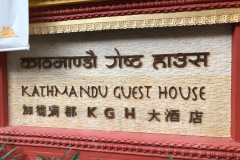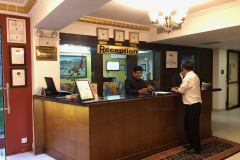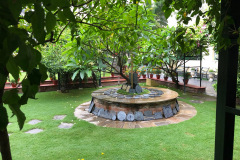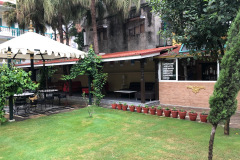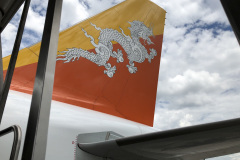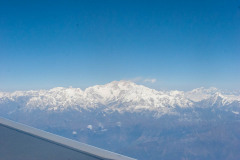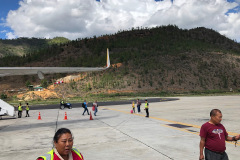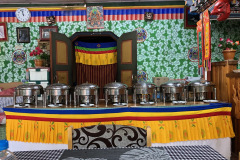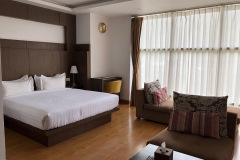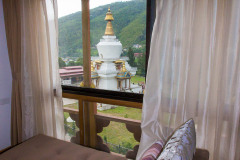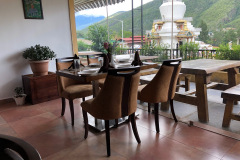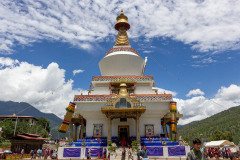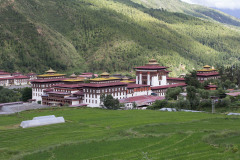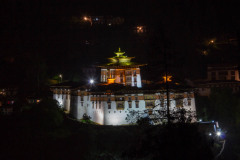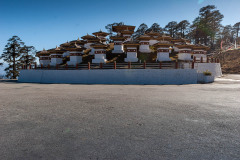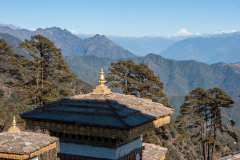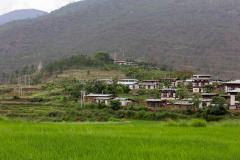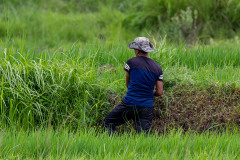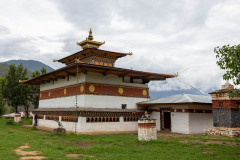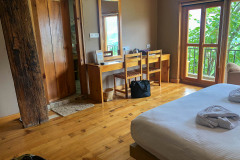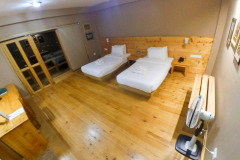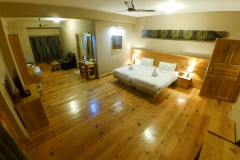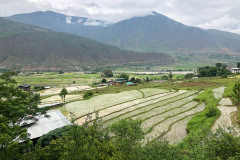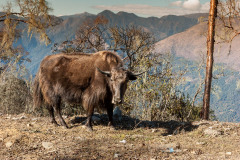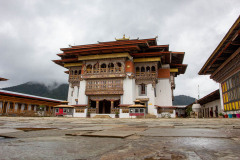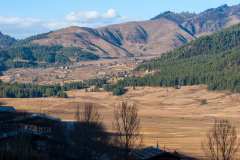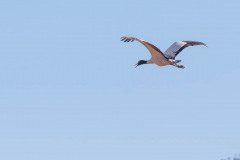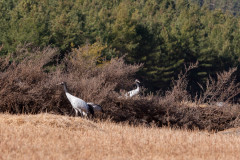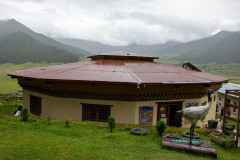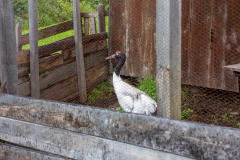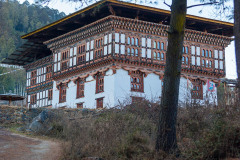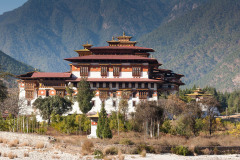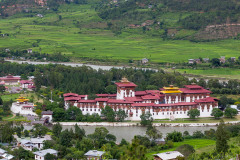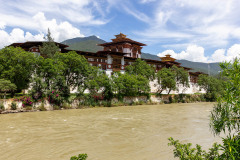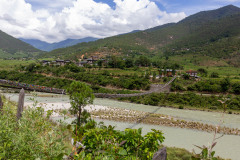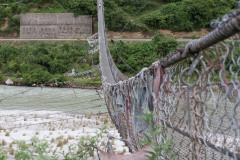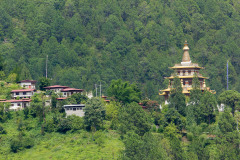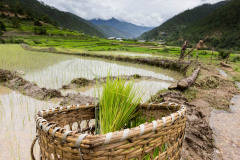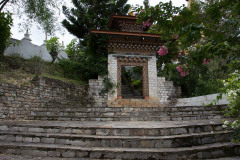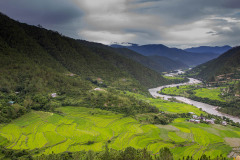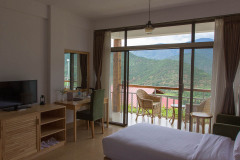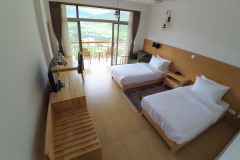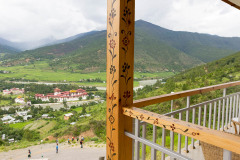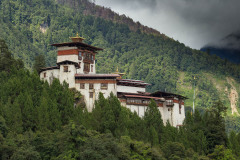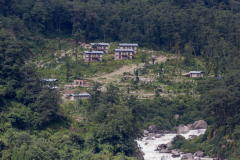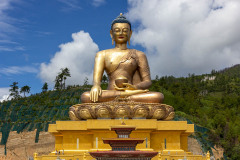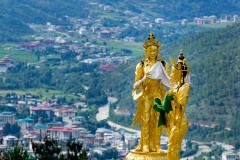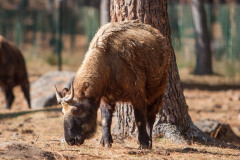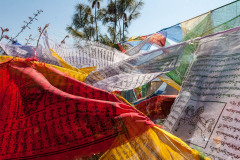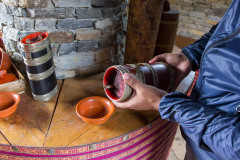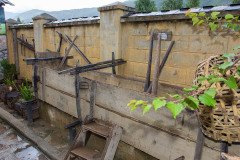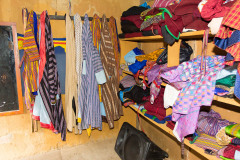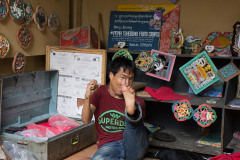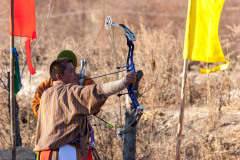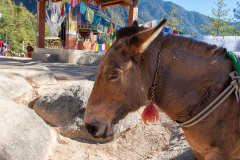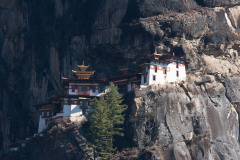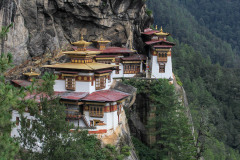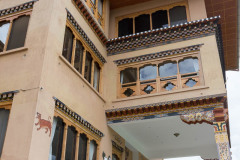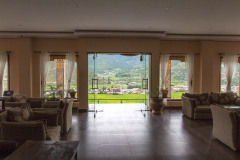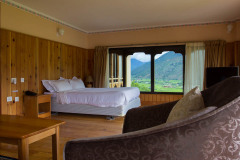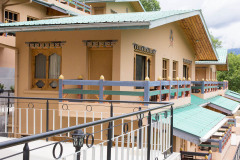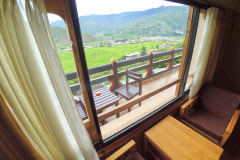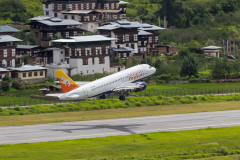December 18, 2019 to December 28, 2019
Note that this is not a private tour with any given departure date but rather a group joining tour starting on the 18th in Kathmandu at the hotel. If you are traveling on your own, it would be necessary to pay the single-supplement for your own room.
If you want to originate from Bangkok or Delhi, we could arrange you to join in Paro on December 19 but there will be a different cost.
Overview of Trip
I tried to find a better word than “automobiles” for the title of the trip but in the end, I just couldn’t resist the phrase. Joking aside, here is why I picked the title:
Cranes
We will be visiting the feeding grounds where the black-necked cranes spend the winters. These amazing birds make the 200 km journey from Tibet each year flying at altitudes of up to 7900 meters to cross the mountains to reach the Phobjikha valley where they spend the winter months. There are only 11,000 of these birds in existence so visiting Phobjikha in December gives us a chance to view these rare birds relatively close.
Planes
We will get to fly from Kathmandu to Paro and experience an amazing view of the Himalayan Mountains (as long as the weather is clear). Generally the skies in the Himalayan region is quite clear during December.
Automobiles
The word was selected just because it sounded good! I wanted to use the phrase “hot water” to emphasize the use of hot water in Bhutan for medicinal purposes through hot springs and hot stone baths. But “cranes, planes, and hot water” just didn’t sound so good!
We will spend one night in Gasa visiting the hot springs. After our hike to Taksang Monastery, we will have a chance to experience a traditional Bhutanese hot stone bath.
The Usual Bhutan Sights
In addition to the cranes, planes, and hot water, we will take in the usual Bhutan attractions like the Tiger’s Nest Monastery, Punakha Dzong, the 108 Stupas at Dochu La, Khamsum Yuelley and Buddha Point.
Your Tour Leader
Robert Ford is originally from Canada but in 2009 but got the chance to move to Qatar where he teaches software programming.
Before moving to the Middle East Robert traveled through North America, South America and a bit of Europe. Moving the Middle East suddenly opened the possibility of exploring countries in Asia.
Robert has visited the small Himalayan country of Bhutan more than a dozen times in the past 10 years since his wife is from Bhutan. The frequent and long trips to Bhutan gives him the chance to spend time visiting different parts of the country to review hotels and to take photos of the attractions to help visitors decide which things they would like to see.
Photo Gallery
Detailed Itinerary
December 18 – Meet in Kathmandu
Today we will be checking into the Kathmandu Guest House (KGH) in Kathmandu. The Kathmandu Guest House is one of our favorite hotels in Kathmandu because it is located right in the middle of the bustling Thamel area with lots of shops and restaurants around but yet has a beautiful private and quite garden where you can relax. We will meet in the lobby of the hotel at 6pm so that we can meet each other.
I encourage visitors to arrive in a Kathmandu a few days early and take in the sights such as Boudhanath and Swayambanath before our trip begins or schedule a few days after the Bhutan tour to enjoy Nepal. If you want a travel agent to arrange your trip, I can provide you with the name of the tour operator that I use.
We will move on to Fire and Ice Pizza for dinner and drinks (this dinner is not included in the tour price). Fire and Ice Pizza is a restaurant in Thamel that was founded by an Italian chef from Naples and is one of the best pizza places in the area.
December 19 – Fly to Bhutan
The breakfast at KGH contains a wide variety of choices from Western, to Indian, to Nepalese dishes and you can decide if you want to eat outside in the garden or inside the dining hall.
We will be heading to the airport approximately 3 hours before our flight. Getting through the airport in Kathmandu can be a bit frustrating, but we will be flying in Drukair’s business class (this flight is included in the price of the tour) so it should be a bit easier. Why are we traveling in business class instead of economy? The fare difference between economy and business class on the Kathmandu to Paro sector is ridiculously small and it will give us the chance to use the upstairs lounge in the airport which has cleaner toilets, better wifi, good food to eat, and comfortable seating.
The weather between Kathmandu and Paro in December is usually clear giving us the most remarkable view of the Eastern Himalayan mountains including Mount Everest. Another reason to sit in business class is that if you end up sitting on the right-hand side of the plane, there will be more space to get a peek out the left-hand side where the mountains will be located.
Landing in Paro is an exciting event as you snake your way between the mountains to the somewhat short runway that hides in the narrow Paro valley. The landing is so spectacular at this airport that most of the time passengers cannot hold their excitement and break out in applause as the plane touches down. Disembarking from the airplane, you will certainly fall into the trap just like every other tourist who has ever arrived in Bhutan… you just can’t help but stop on the tarmac to take photos of the plane and the amazing mountain scenery that you just flew though. Don’t worry, airport staff are used to this and will not get angry if you stop for a couple of minutes to take some pictures.
All groups to Bhutan must be accompanied by a local licensed guide and after passing through immigration and collecting our bags we will meet our guide and our driver who will be with us for the rest of the tour.
he first order of business will be likely to eat lunch (depends on the flight time). The food will most certainly be served as a buffet consisting of red rice from the Paro valley along with various vegetable and meat dishes and of course the national dish of Bhutan, emma datsi.
After completing our lunch, we will drive to the capital city Thimphu (about 1 hour) and will check in to our hotel. We will then visit the National Memorial Chorten followed by a visit to Taschichho Dzong to see the lowering of the flag ceremony. We will return to Taschichho Dzong later tonight after dinner to see this incredible fortress illuminated.
December 20 – Drive to Lobesa
This morning we drive towards Punakha, the ancient capital of Bhutan. About 45 minutes into our journey, we will reach Dochu La pass at 3100m (10,171 feet) where we will stop for a tea break and were we can visit the 108 stupas built in memory of the Bhutanese soldiers killed during the first ever operation conducted by the Royal Bhutan Army.
Besides the 108 stupas, the view of the mountains from this pass is fantastic. With a telescope pointed in the right direction on a clear day, it is possible to view Gasa Dzong 45km away.
Reaching Punakha, we will have our lunch followed by a visit to Chimi Lhakhang. This monastery stands on a small hill and we need to make a short 25-minute hike through some rice. The temple is built on a site where Lama Kunley (also known as the Divine Madman) subdued a demon of Dochu La.
The “Divine Madman” got his name from this strange and unusual ways of teaching Buddhism through singing, humor and other behavior. This teacher also happens to be the saint who encouraged the use of the phallus symbols that you will see on all of the buildings in Bhutan. The template is also known as the temple of fertility and there are many stories of both locals and foreigners visiting the temple who were unable to bear children becoming parents after visiting this temple.
December 21 – Drive to Phobjikha Valley
Today we will head to further east to the town of Gangtey and the Phobjikha. We will keep an eye out for yak along the side of the highway. The yaks have moved down from their higher-altitude areas because of the snow. The photo of the yak included on this page was taken near Gangtey at elevation of around 3250m.
Arriving in Gangtey, we will eat our lunch and visit the Gangtey Monastery. It is said that when the black necked cranes arrive from Tibet in November they circle this monastery 3 times before flying down and landing in the valley.
Hopefully you have brought some warm clothes because from the monastery we will hike down following the Gangtey Nature Trail. The trail takes about 90 minutes and gives you a chance to enjoy a quite walk through nature. If you are lucky the cranes might be close enough to be visible from the trail.
After completing the nature trail at Khewa Lhakhang, the driver will be waiting to pick us up to take us to the crane information center. Inside the center you can watch a short 20-minute documentary about the cranes and we can use the telescopes at the center where we can stay warm and take a closer look at the cranes. We will also get a chance to visit “Karma”. Karma is a crane with an injured wing. Rather than allowing the crane to be attacked by dogs, it was decided that an enclosure be built to protect the animal and allow for people visiting Phobjikha during the summer months to see an actual crane.
Rather than staying in a regular hotel tonight, we will instead be staying in one of the numerous farm houses in the Phobjikha valley. This will give you a chance to meet some of the locals and eat the food that they prepare. The one warning about the Phobjikha valley during December, it is going to be very cold. The farmhouse will have the main living room heated with a wood stove and they will probably provide some hot water bottles that you can put into your bed in order to keep yourself warm through the night along with the numerous heavy blankets they provide.
December 22 – Drive to Punakha
This morning, you will likely be a bit chilled from the low overnight temperatures, but the good news is that Punakha is going to be much warmer.
Reaching Punakha (about a 3 hour drive), we will eat lunch and move onto Punakha Dzong. Punakha Dzong is probably the most beautiful dzong in all of Bhutan. Sometimes in Punakha Dzong, you can hear a puja (prayer) happening. During the puja you can hear the monks chanting, beating drums and playing their horns. It is an incredible powerful experience just to listen to.
After the dzong, we will walk up to the 230-meter suspension bridge connecting the dzong to the villages on the opposite side of the Po Chhu river. If you are not bothered by heights (and a swinging suspension bridge), you can walk out to the middle of the bridge to get some nice photos.
We next continue a bit further north to visit Khamsum Yuelley Chorten. We start by crossing the Mo Chhu river on a small suspension bridge, walk along the edge of some rice terraces, and finally begin the 45-minute hike to the chorten. Sometimes we are lucky and the balcony on the top level of the chorten will be open and we can get an amazing picture of the valley looking south towards Punakha.
December 23 – Gasa Hot Springs
Today we will head off to Gasa, the least populated dzongkhag (district) in Bhutan. This district hardly receives any tourists, but it doesn’t mean it isn’t worth the trip up. The drive up is going to take between 2 and 3 hours over a relatively rough and unpaved road. We will start with visiting the Gasa Dzong.
Although it is yet another dzong and you might be tired of seeing them, this dzong does provide a great view of the valley and mountains towards the south. The view of the dzong itself is also amazing with the large snowcapped mountain behind it.
After the dzong, we will move down to the Gasa hot springs. There are a number of pools of hot water with different temperatures providing different medicinal values. Although we are not likely to see many foreign tourists, these hot springs will be filled a lot of local people visiting these springs during December.
After the dzong, we will move down to the Gasa hot springs. There are a number of pools of hot water with different temperatures providing different medicinal values. Although we are not likely to see many foreign tourists, these hot springs will be filled a lot of local people visiting these springs during December.
There are no accommodations at the hot springs so we have no choice but to sleep in tents tonight. We will arrange for all of the camping equipment (including the food) except for the sleeping bags that you will need to bring. The sleeping bag should be rated for zero degrees celsius. If you don’t own a sleeping bag, you can buy them relatively cheap in Kathmandu. Of course, watch out, the quality of the trekking equipment in Kathmandu is not really great but we only need it to last a single night.
December 24 – Return to Thimphu
Unfortunately this is going to be bit of a dull day as we need to make our way back to Thimphu and it will likely take us 6 hours total. The road takes us back through Punakha and over Dochu La pass so we can stop there for more photos if you wish.
Along the way is Simtokha Dzong, the oldest dzong in Bhutan. If there is interest, we can stop or we can just continue on to Thimphu for the hotel.
Because of the long drive today we will not try to take in any sights and simply head for the hotel.
For those in the group who are interested, we can arrange a small excursion to the craft bazaar. The craft bazaar in Thimphu is a long stretch of nearly 400 meters consisting of about 80 shops selling various handicrafts and souvenirs. Given that it will be the low season we might find that only half of the shops are open but if you are looking for something to take back home, it is a good place where you can find every type of souvenir that you can purchase in Bhutan.
Dinner today will be held at a restaurant where we have arranged a small cultural show where you can experience traditional Bhutan music and dance.
December 25 – Thimphu Sightseeing
The first item today will be a trip to Kuenselphodrang, also known as Buddha Point. Having been here a number of times to take pictures at different times of the day, I can assure you that the pictures taken in the morning will turn out much better because the sun will be behind you rather than behind the statue. For those looking for some additional exercise, we can hop out of the van at the foot of the 287-step stairway to the statue.
The main feature of Buddha Point is the large Buddha statue overlooking the Thimphu valley. While it is not the largest Buddha statue in the world, it is still impressive at 52 meters in height. If you are interested, you may enter the temple in the base where there are 125,000 small Buddha statues.
From Buddha Point we will move North to the Takin preserve. The preserve is an 8.4 acre protected area containing a number of takins along with some other animals such as deer. The takin is the national animal of Bhutan and has a very curious legend about its origin that you will learn from our guide.
Up the road a bit further from the takin preserve, we will reach the transmission tower of the Bhutan Broadcasting Service (BBS). We are not here to look at the transmission tower but rather than amazing view of the Thimphu valley. The area is covered in colorful prayer flags and when you are there, the only thing that you will hear is the fluttering of those flags. It is a very pleasant place to visit.
It is likely close to lunch time by now, so we will head to “Simply Bhutan”. Simply Bhutan is a living museum where you will have a chance to immerse yourself in Bhutanese traditions (this is a museum where you are allowed to touch things). You can sample some local rice wine, take pictures in a national dress, try some archery, and enjoy a Bhutanese lunch. You will also get to meet a talented craftsman by the name of Pema Tshering. Pema was born with cerebral palsy and is unable to use his hands but has learned how to do extremely detailed carvings using his feet!
Our final stop in Thimphu is going to be the archery grounds where there are usually a lot of locals playing. Sometimes there are official matches going on while other times it is just for fun (maybe there is some wagering going on but officially that is not allowed). You can watch the locals try to distract the shooting team and making fun of each other as they miss the target and see the victory and defeat dances as the teams score points.
Alternatively there is also the Bhutan Post Office. Bhutan has won many awards for their stamp designs and if the group is interested we can drop by to look/buy stamps and visit the museum.
We will now leave Thimphu and head back to Paro so that we are in a good starting position for our grand finale tomorrow.
It is unlikely that we will be staying directly in the town of Paro. The town is full of dogs that are bark loudly at night and staying away from the town is a much better option. If there are things that you need to get in the town such as souvenirs, let us know and we will stop along the way before reaching the hotel for dinner and the evening.
December 26 – Tiger’s Nest Hike
Chances are, this is the most important day that you have signed up for on our trip. Out of all the amazing things in Bhutan, this one monastery is by far the most popular and iconic symbol of Bhutan.
The drive up to the parking lot from the hotel is going to be just 30-40 minutes but then the real work begins; the part here you have to walk. After reaching the parking lot and walking about 10 minutes you’ll get your first glimpse of the monastery. Your initial reaction might be just like mine; we can reach that in about 30 minutes. Unfortunately, you will discover over the next hour is that the temple is actually locate 900 meters higher than your starting elevation and this is going to be a long walk up.
The amount of time it takes will depend on the person walking. Most people can make it to the cafeteria in about 1 hour, but we know that sometimes it takes people a lot longer. The trip from the cafeteria to the lookout point is another 30 to 45 minutes and then you need another 30 minutes on the steps to reach the actual monastery. If you think that you will not be able to make the steep climb, we can arrange a pony (extra cost) to make it to the cafeteria but these days it needs to be arranged at least the day before.
The official name of the monastery is Paro Taksang. The name taksang, meaning tiger, comes from the legend that Guru Rimpoche reached a cave at this location by transforming his wife into a flying tigress and then flew to the site on the back of the tigress. Upon reaching the cave he then meditated for a period of 3 years, 3 months and 3 days.
After completing the trip to the tiger’s nest monastery, we will visit Kyichu Lhakhang, one of the oldest temples in Bhutan then move to an old farmhouse where we can have tea and you can experience a traditional hot stone bath to help relieve the pain from today’s hike.
December 27 – Departure
Unfortunately, today is the final day of our trip. We will be dropped at the airport for the morning flight. I did not include the flight in the trip price because you may want to head directly to either Delhi or Bangkok to continue your tour of Asia or to catch your flight home. Our tour operator in Bhutan can arrange this one extra flight.
I will be on the flight with those people heading back to Kathmandu where I will be staying for just a few hours and then heading back to my home.
Price
The trip is $2525 per person. If you want/need a single room there will be an additional $300 per person.
The price assumes that we can form a group of 3 people minimum. If you are interested in going and we do not get sufficient people we can create a package for you but the cost may be different.
Inclusions
- 1 night in 3-star hotel in Kathmandu (based on twin sharing)
- Transfer from hotel to Kathmandu airport
- Flight from Kathmandu to Paro in business class
- Visa Fee for Bhutan
- Licensed English speaking guide in Bhutan for entire trip
- Local transportation in Bhutan
- 8 nights in 3-star hotels in Bhutan (based on twin sharing)
- Water during the drive
Exlusions
- Visa fee for Nepal
- Airfare from Bhutan to next country
- Food in Nepal other than breakfast
- Beverages
- Tips
- Donations to monasteries
Note about Hotels
Although I have mentioned specific hotels, there is a chance that the hotels will not be available. We will substitute for equivalent hotels in the same locations if necessary. Since it is the low season, we expect that the hotels should be available.
How to Book
For this trip, you have the option of booking directly with us through our contact form or by email (info@bhutanpeakadventure.com). You may also use the website Escape With Pro. The price is the same regardless of which route that you take.


